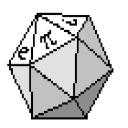Yahoo Answers is shutting down on May 4th, 2021 (Eastern Time) and beginning April 20th, 2021 (Eastern Time) the Yahoo Answers website will be in read-only mode. There will be no changes to other Yahoo properties or services, or your Yahoo account. You can find more information about the Yahoo Answers shutdown and how to download your data on this help page.
Trending News
Partitions into ALMOST equal rectangles?
In how many ways can N blocks be arranged into two rectangles so that the first rectangle is one unit wider than the second, which is one unit taller than the first?
The first value of N for which this is non-zero is 4 = 2×1+1×2. <count is 1>
The next N with a non-zero count is 7 = 3×1+2×2 = 2×2+1×3 <count is 2>
The first N with a count of 3 is 40 = 14×1+13×2 = 4×5+5×4 = 2×13+1×14
This question was originally asked by Izjed:
http://ca.answers.yahoo.com/activity?show=s4xnCYKV...
but went unanswered.
The original distinguished "height" from "width", (and allowed neither to be zero in either rectangle), so the counts I gave are the ones I want.
1 Answer
- gianlinoLv 79 years agoFavorite Answer
Looks to me like the count of 7 is 1 and count of of 40 is 2. The unions should be non isometric right?
Anyway, set A = mn + (m + 1)(n - 1).
Then 2A = 4mn +2n - 2m - 2 = (2m + 1 )(2n - 1) - 1.
So all you need is to count the distinct factorizations of 2A + 1
For A = 40 , 2 A + 1 = 81 and you indeed have only 2 factorizations 9*9 and 3*27.
To have 3 non isometric decompositions you can use A = 52 2A+1 = 3*5*7
(m,n) = (1,18), (2,11),(3,8)
52 = 1*18 + 2*17 = 2*11 + 3*10 = 3*8 + 4*7


